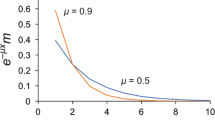Abstract
The Lansing Effect, simply stated, is that the offspring of old parents tend to have shorter lifespans than the offspring of young parents and in both cases these tendencies are transmitted to successive generations. This statement is difficult to justify from Lansing’s data because of the variation in mean lifespan that was observed from one generation to the next. A more precise statement of the Lansing Effect is that isogenic lines derived from young parents tend to persist for more generations than lines derived from old parents.
Lansing considered aging to be the result of a factor that was transmitted from mother to offspring via the eggs. He proposed that this factor influences longevity and also alters the pattern of reproduction. Members of short-lived lines derived from old parents reproduced earlier and at higher rates in succeeding generations. In contrast, members of long-lived lines derived from young parents delayed initial reproduction to later age classes in succeeding generations. These proposals are examined using a life table analysis of Lansing’s data. The results suggest that the Lansing Effect in Philodina citrina is not due to aging, but rather is the direct result of the changes in fecundity patterns. Accordingly, it would seem prudent to regard the Lansing Effect with some skepticism until more is known about its physiological basis.
Access this chapter
Tax calculation will be finalised at checkout
Purchases are for personal use only
Preview
Unable to display preview. Download preview PDF.
Similar content being viewed by others
References
Birch, L.C., 1948. The intrinsic rate of natural increase of an insect population. J. anim. Ecol. 27: 15–26.
Charlesworth, B., 1980. Evolution in Age-Structured Populations. Cambridge University Press, Cambridge.
Dingle, H. & Hegmann, J.P. Eds., 1982. Evolution and Genetics of Life Histories. Springer-Verlag, New York.
Jennings, H.S. & Lynch, R.S., 1928. Age, mortality, fertility and individual diversities in the rotifer Proales sordida Gosse. I. Effect of the age of the parent on characteristics of the offspring. J. exp. Zool. 50: 345–407.
King, C.E., 1967. Food, age, and the dynamics of a laboratory population of rotifers. Ecology 48: 111–128.
King, C.E., 1969. Experimental studies of aging in rotifers. Expl. Gerontol. 4: 63–79.
King, C.E., 1982. The evolution of lifespan. In: Dingle, H. & Hegman, J. P. (Eds.). Evolution and Genetics of Life Histories. Springer-Verlag, New-York: 121–138.
King, C.E. & Miracle, M.R., 1980. A perspective on aging in rotifers. Hydrobiologia 73: 13–19.
Lansing, A.I., 1942a. Some effects of hydrogen ion concentration, total salt concentration, calcium and citrate on longevity and fecundity of the rotifer. J. exp. Zool. 91: 195–211.
Lansing, A.I., 1942b. Increase of cortical calcium with age in the cells of a rotifer, Euchlanis dilatata, a planarian, Phagocata, sp. and a toad, Bufo fowleri, as shown by the microincineration technique. Biol. Bull. 82: 392–400.
Lansing, A.I., 1947. A transmissible, cumulative and reversible factor in aging. J. Gerontol. 2: 228–239.
Lansing, A.I., 1948. Evidence for aging as a consequence of growth cessation. Proc. natn. Acad. Sci. 34: 304–310.
Lansing, A.I., 1954. A nongenic factor in the longevity of rotifers. Ann. N.Y. Acad. Sci. 57: 455–464.
Lints, F.A., 1978. Genetics and Aging. Interdisciplinary Topics in Gerontology, Vol. 14. Karger, Basel.
Lints, F.A. & Hoste, C., 1974. The Lansing effect revisited - 1. Lifespan. Expl. Gerontol. 9: 51–69.
Rougier, C. & Pourriot, R., 1977. Aging and control of the reproduction in Brachionus calcyciflorus (Pallas) (Rotatoria). Expl. Gerontol. 12: 137–151.
Snell, T. W. & King, C. E., 1977. Lifespan and fecundity patterns in rotifers: the cost of reproduction. Evolution 31: 882–890.
Stearns, S. C., 1976. Life history tactics: A review of the ideas. Q. Rev. Biol. 51: 3–47.
Author information
Authors and Affiliations
Editor information
Rights and permissions
Copyright information
© 1983 Dr W. Junk Publishers, The Hague
About this paper
Cite this paper
King, C.E. (1983). A re-examination of the Lansing Effect. In: Pejler, B., Starkweather, R., Nogrady, T. (eds) Biology of Rotifers. Developments in Hydrobiology, vol 14. Springer, Dordrecht. https://doi.org/10.1007/978-94-009-7287-2_15
Download citation
DOI: https://doi.org/10.1007/978-94-009-7287-2_15
Publisher Name: Springer, Dordrecht
Print ISBN: 978-94-009-7289-6
Online ISBN: 978-94-009-7287-2
eBook Packages: Springer Book Archive




